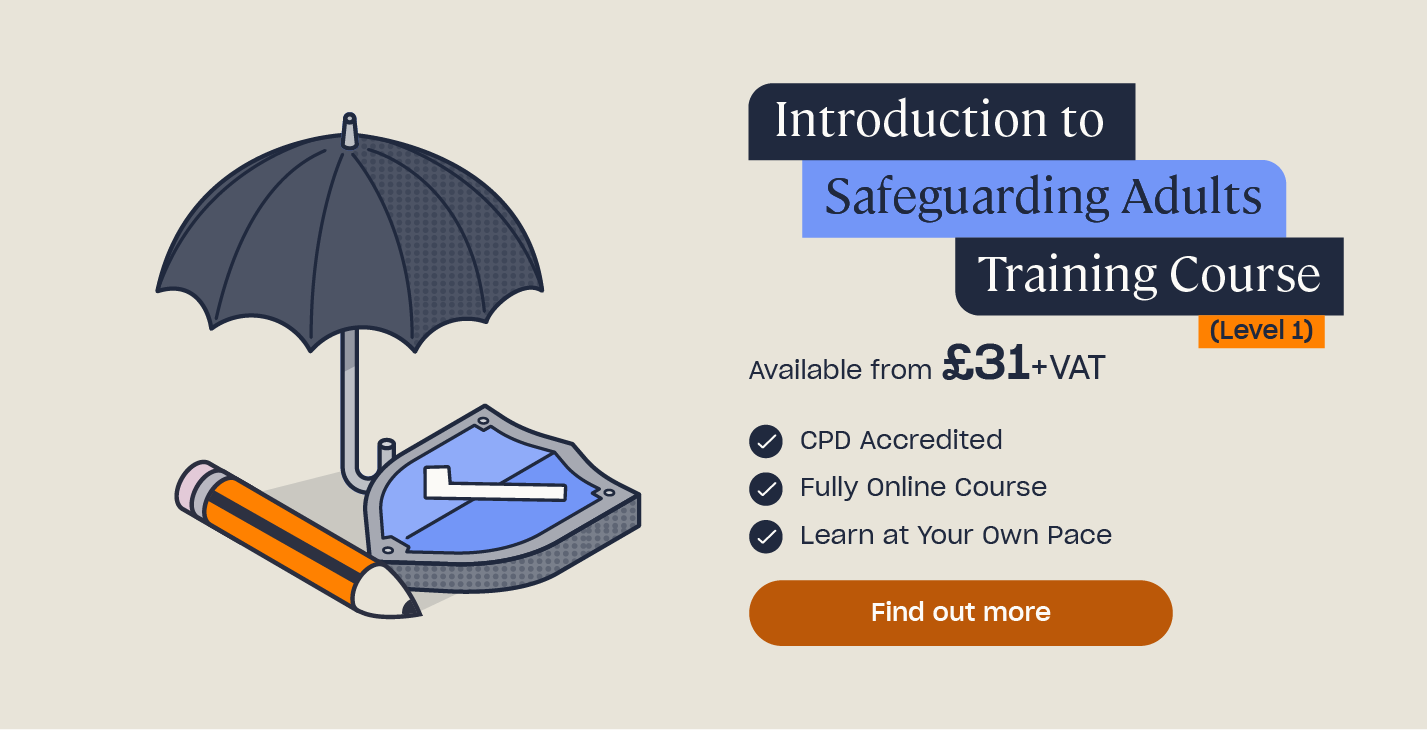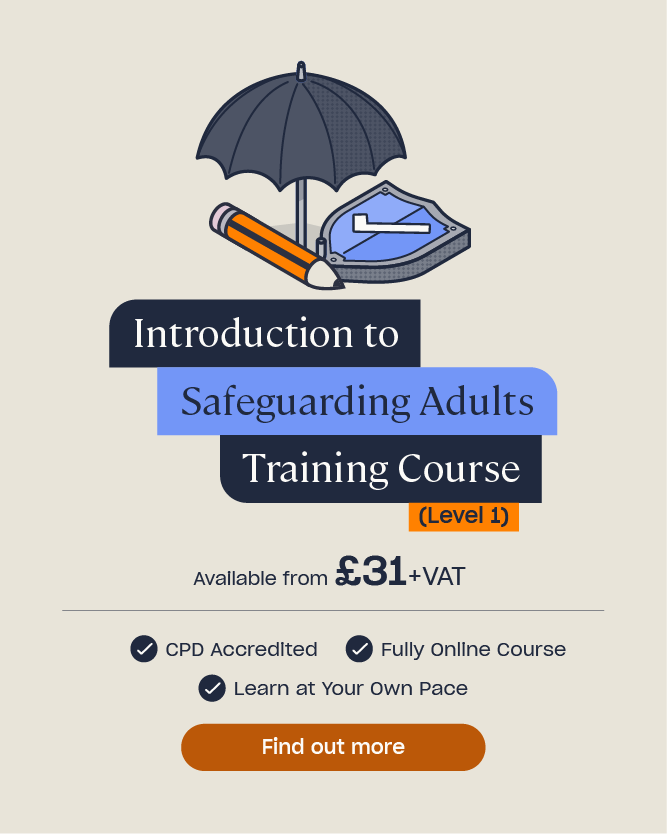Risk Enablement: Making Safeguarding Personal
Health and social care services provide care, treatment and support to individuals. If you work in health and social care, you have a responsibility to promote individuals’ wellbeing, care for them and prevent them from harm.
Promoting wellbeing with the goal of achieving the best outcomes for the service user sometimes involves risk. Positive risk taking involves taking carefully considered risks that create positive outcomes for the service user, such as improved wellbeing and promotion of independence and dignity.
Risk enablement is important in health and social care because it empowers individuals to have control over their lives. Allowing service users to make their own decisions is a vital part of person-centred practice. This article discusses what risk enablement is, why it is important and how you can support this approach in your work.
What is Risk Enablement?
Risk enablement is not about encouraging individuals to engage in risky activities such as going sky diving or driving fast cars. It is about letting individuals take control over their lives, making decisions, either good or bad, then learning from the outcomes of those decisions.
Everyone in your care has the right to take risks, no matter how uncomfortable it makes you feel. With that said, safeguarding and duty of care are still incredibly important considerations when someone you work with is making a choice.
If an individual wants to partake in an activity that has potentially negative risks associated, they should be able to do it. Supporting them to identify the negative consequences associated, then finding a way to minimise them, is how you can ensure they are safe while still remaining in control of their own decisions.
Risk enablement is an approach that recognises that carefully considered risks can empower individuals, enable them and help improve their wellbeing. In this circumstance positive refers to the outcome, not the risk. As a carer you want to protect the individual, however this protection often refers to physical health and neglects the impact on a person’s emotional and psychological wellbeing.
Practitioners need to be supported by care providers to incorporate risk enablement and safeguarding into their person-centred work. Therefore, senior managers in health and social care should implement a guide. Where care workers have followed the guidelines given, their protection from liability and support from managers will be enhanced.
Risk taking should involve everybody working together to achieve positive outcomes for the service user. Employers, employees, family, friends, advocates and most importantly the service user themselves, should all be involved in the process. Consequently, anyone aware of or involved in assessing the potential risks carries a responsibility to do something about them.

Benefits of Risk Enablement for Service Users
Risk enablement gives service users more control over their life, resulting in improved overall wellbeing. It also helps those working in health and social care to operate in a person-centred way as it makes safeguarding personal. Furthermore, risk enablement gives family and friends involvement with important decisions and reassures them that their loved one is being cared for in a way that meets their specific needs.
Allowing the individual to make decisions about their care also promotes wellbeing as it gives them control over their life. Enabling individuals to take risks will allow them independence which can in turn boost their self-esteem. Once the individual has communicated their goals or things they would like to do, it is your responsibility as a health and social care worker to try your best to make it happen.
A recent CQC report rated a care home in Kent outstanding, with the inspector pointing out ‘people were supported to take positive risks, maximising control over their lives’. This demonstrates that risk enablement can succeed through positive risk taking.
Risk is integral to most activities and choices, and it is important to remember risk can be minimised but not eliminated. Risk is also specific to the individual, their circumstances and is dynamic so it can change over time.
Examples of Risk Enablement
Below are some examples of how risk enablement may look in practice:
Social Care
A service user taking the bus to town to visit a café or the shops could be on their own or with support. Going on their own gives them valuable social interactions and allows them to explore at their own pace. The risks considered address things that could go wrong and what to do if anything does go wrong. Assessment of risk allows carers, family and friends to have confidence that the risk is worth taking. Precautions to take in this example could include ensuring the service user has a mobile phone with them to get in contact if needed and enough taxi or bus money.
Care Home
Service users in a care home could go swimming, driving or play golf. These may seem like ordinary and risk-free activities for most people and could be taken for granted as they are not considered to have any risks associated. However, for those who are frail or have certain health or mobility issues these activities carry a large amount of risk and would have to be assessed to ensure the safety of the service user.
Childcare
Allowing children to take risks can develop their confidence to be able to cope in challenging situations. Positive risk taking also expands children’s skills and put them in a position where they think about others and the consequences of their decisions. Using tools in the kitchen or scissors in crafts are activities that allow children to take risks. In order to keep the child safe, observation during these activities balances the need for safety with the need to explore risks.

The Key Principles of Risk Enablement
When planning risk enabling activities, it is essential to remember that the most important part of the process, is the individual. The service user should be at the centre of the process so they can understand the risks involved and decide for themselves if they are willing to positively take risks to achieve a goal.
Spending time with the service user discussing and planning exciting activities develops a trusting relationship. This relationship is important as it allows the service user to feel safe, therefore making them more inclined to feel comfortable taking risks.
Planning any risk taking activities should centre around the service user’s specific strengths. This provides a positive approach to enabling the service user to partake in activities that cater to their abilities and will develop their overall confidence.
There are some key principles involved in risk enablement:
Involving the adult
Some questions you could ask the individual are:
- What is important in your life?
- What is working well?
- What things are difficult for you?
- Do you think there are any risks?
- Could things be done in a different way, a way that might reduce the risks?
- Who is important to you?
- Are there any differences of opinion between you and the people you said are important to you?
Involve the adult’s network 
Involve and collaborate with other agencies 
Assess risk 
Risk management 
Considering how to mitigate the risk is called risk management. The process should involve the individual and those important to them.
The aim of risk management is to find a balance between safety and wellbeing, whilst also ensuring the safeguarding outcome is what the individual wants to achieve.
This process uses resources and assets surrounding the individual as well as the community.
An important consideration is the impact of mitigated risks on the individual’s wellbeing, before identifying how to reduce or manage the potential negative impacts.
Emphasis should be placed on finding a balance between reducing the risk and the impact that it will have on the individual.
Risk to others
The individual’s right to take risks does not give them the right to put others at risk.
Mental capacity
Where doubt exists in the individual’s thoughts or decisions, ensure the mental capacity act principles are followed.
Advocacy 
Complex situations
Where an agreement with the adult is not possible or is refused, a defensive decision will be collectively taken where there is a continual risk of harm.
Assess the impact of any mental health concerns on decision making.
Risk management plans can involve many people including organisations and support services. Everyone involved in the plan needs to know the extent of their involvement to ensure all tasks and procedures are followed correctly.
Information sharing
Defensible decision making
Records should include:
- The reason for decisions.
- How the decisions are balanced.
- How the individual has been supported with weighing up the decisions.
- When the decisions are reviewed and how they will stay up to date with relevant legislation.
There may be occasions where new, unfamiliar, urgent or potentially high-risk circumstances emerge which are not covered within the standard procedures and documentation. In these circumstances, it may be necessary to seek further legal advice before continuing the risk assessment.
How Can This Approach be Supported?
There are a multitude of ways to support this approach to ensure risk enablement is used in a safe and effective way. Communication is highly important and involves everyone in the risk taking process. Using communication led by the language and understanding of the person using the service supports risk enablement to be implemented effectively.
For managers to promote risk enablement, fostering a culture of positive risk taking and supporting workers is essential. A culture of supportive learning from good or bad decisions, reflective supervision and emphasis on evidence-based practice should all be taken into consideration when implementing risk taking in a care service.
This approach is a core part of self-directed and person-centred support, including assessments and regular review of outcomes. Risk enablement is a key skill for health and social care workers when promoting wellbeing to achieve an outcome and it can be applied for different individuals and across different settings.
In your work, if you notice a decision has been made that eliminates any chance of risk taking, or a decision has been made without input from the service user, speak up. If you think a decision should be reconsidered, mention it to a senior member of staff to see if anything can be done.

How to Promote Wellbeing in Childcare
From a young age, promoting wellbeing in children is important to keep them safe and help them develop to ensure they have positive outcomes in adulthood. Anyone who works with children or young people has a responsibility to promote their wellbeing, recognise any concerns and know what action to take to keep children safe.
Positive experiences can help improve a child’s mental health, however negative experiences can adversely affect mental health. Many areas in the UK have established Multi Agency Safeguarding Hubs (MASHs) to ensure children’s safeguarding is effective and communication between professionals is improved. MASHs allow early identification of risk for children and improve information sharing, allowing coordinated action to keep children safe.
Promotion of wellbeing is a central part of safeguarding children. Simple methods such as talking and providing support can make an incredible difference to their mental wellbeing. Another way to promote this is through risk enablement, which views risk as a positive experience and allows children to have control over their decisions and take risks in a safe way.
Activities such as climbing trees or using tools for gardening or crafts have associated dangers and the potential to cause injuries. However, if they are done in a planned way to minimise risk or negative outcomes, these activities can have positive impacts on children’s confidence, self-esteem and abilities.
How to Promote Wellbeing in Social Care
Promoting wellbeing in social care is incredibly important, but to do this you need to know the service user’s goals and wishes. Different things affect peoples’ wellbeing in different ways, therefore it is crucial that care is provided in a person-centred way and is subjective to the individual.
If you work in health and social care you have a responsibility to promote wellbeing, along with the care provider, the service user and their family or friends. Knowing what the service user wants to achieve or what they enjoy doing will give you a good place to start.

In social care, wellbeing includes:
- Treating the service user with dignity and respect.
- Protecting the service user from neglect or abuse.
- Giving the service user choice over how they receive care and spend their day.
- Providing service users with opportunities to participate in social, educational and recreational activities.
Every decision comes with a risk, so it is up to you as a carer or member of their support network to ensure you are aware of and minimise the potential negative consequences.
Risk enablement allows service users to have control over their decisions and take risks. The process of positive risk taking promotes independence and improves wellbeing. If you work in health and social care you have a responsibility to understand the importance of risk enablement and to support service users in positive risk taking.
Further Resources:
- Introduction to Safeguarding Adults Training Course
- What is Person-Centred Care
- Duty of Care in Health and Social Care
- Activities for Care Homes: Free Planner and Ideas
- How Can We Work Together to Safeguard Adults?
- What is Advocacy in Health and Social Care?
- Promoting Independence in Health and Social Care











